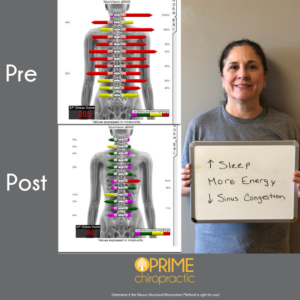Why should you care if your spine has a problem?
Because your spine protects the most vital organ system in your body, your Nervous System.
And if you have a problem with the shield of bone, called your spine, then you will also have problems with your nervous system, which runs inside it.
Furthermore, if you have problems in your nervous system, you will see effects elsewhere in the body. This is because the nervous system controls every cell, tissue, and organ.
Believe it or not, core problems in the spine and nervous system can cause a lot more trouble than just pain.
When it comes to the spine, most people know chiropractors work with it.
With that said, not all chiropractors are the same…just like not every medical doctor is the same.
Traditional Chiropractors make up the majority of chiropractic in America. These chiropractors focus on short-term pain relief and increasing range of motion.
There’s nothing wrong with this approach. It helps a lot of people every year.
However, what we focus on at Prime is something called: Neuro-Structural Restoration.
We’re primarily concerned with core problems in your spine and nervous system, that may be contributing to your pain, and what brings you in. But, they may also be contributing to things you’re not aware of.
What do I mean by not aware of?
It could be any symptom that you haven’t connected to your nervous system. For example, sleeping difficulties, trouble with focus/concentration, brain fog, low-energy, digestive upset, high-blood pressure, hormonal imbalance, etc.
How can a core problem in the spine and nervous system lead to any of these issues?
Here’s how…
Your brain controls and instructs everything in your body. It uses the nervous system as a communication highway to instruct the rest of the body.
Also, the brain has a limited supply of energy throughout a day…and it uses the energy to run the rest of the body.
When it comes to the billions of tasks the brain has to do on a daily basis, there are a few which are higher up the list.
One of the top priorities is keeping you upright, instead of face-down in a ditch (you wouldn’t last terribly long there).
That’s a primary concern for your brain, so it does everything possible to keep you standing tall, and balanced.
How it does that is through tiny postural muscles, called Multifidi. These muscles are attached directly to your spine, and are under your sub-conscious control, meaning you can’t control when they’re on, or off.
When there’s any shifting in the spine, these muscles become hyperactive.
Why?
Because if they don’t you will quickly become off-balance, and eventually fall over.
So, the brain uses as much energy as necessary to fire these muscles when there’s shifting in your spine.
Here’s why that’s sooo important…
If your brain is spending more energy than normal on keeping you upright, that means less energy going everywhere else the brain controls. For example, the heart, hormones, digestive organs, moderating pain levels, etc.
When there’s a lot of shifting in the spine, this translates to a brain that isn’t working very efficiently. Think of a 1990’s Chevy Suburban that guzzles gas, and then compare that to a 2018 Toyota Prius that is ultra-efficient.
You spend a lot less money on gas with the Prius, just like your brain spends a lot less energy on a spine with no core problems.
In our office, we use computerized, objective findings to help us measure if any Neuro-Structural work is needed.
One of the objective tests we run is called SEMG Analysis (Static Electro-Myography).

This test measures how hard your brain is working to keep you upright at any point in time.
There are a few important nuances in the analysis, but one of the most important is this…
If your Stress Score is below 110, then your brain and nervous system are running pretty efficiently, and you don’t need our help.
However, if your stress score is above 110, then we have work to do.
An important fact…
You don’t have to be in pain, or experiencing symptoms to have a high SEMG Analysis score.
Why?
Only 20% of your nervous system is Sensory (only 20% can feel anything).
The rest is Autonomic, and is strictly meant to control function (think about it…you don’t feel when your stomach secrets HCL Acid, right?).
Furthermore, you could feel amazing, go to your doctor, and be diagnosed with high-blood pressure.
My point is this: feeling good doesn’t mean you’re healthy.
After all, you could feel great, go to your doctor for a routine check-up and be diagnosed with heart disease. It’s not about how you feel.
Similarly, you could feel great and have a really poor functioning nervous system…that’s why we measure and test.
To answer the headline of this blog post, the only way to know if your spine has a problem is to have it measured.
